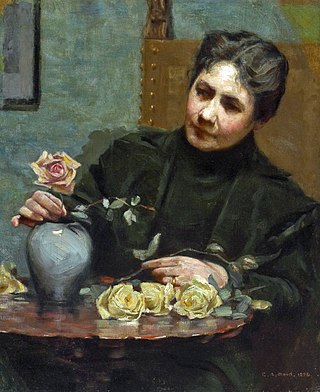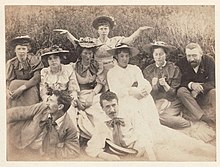
Floriography is a means of cryptological communication through the use or arrangement of flowers. Meaning has been attributed to flowers for thousands of years, and some form of floriography has been practiced in traditional cultures throughout Europe, Asia, and Africa.

Sarah Biffen, also known as Sarah Biffin, Sarah Beffin, or by her married name Mrs E. M. Wright, was an English painter born with no arms and only vestigial legs. She was born in 1784 in Somerset. Despite her disability she learned to read and write, and to paint using her mouth. She was apprenticed to a man named Emmanuel Dukes, who exhibited her as an attraction throughout England. In the St. Bartholomew's Fair of 1808, she came to the attention of George Douglas, the Earl of Morton, who went on to sponsor her to receive lessons from a Royal Academy of Arts painter, William Craig. The Society of Arts awarded her a medal in 1821 for a historical miniature and the Royal Academy accepted her paintings. The Royal Family commissioned her to paint miniature portraits of them. When the Earl of Morton died in 1827, Biffen was left without a noble sponsor and she ran into financial trouble. Queen Victoria awarded her a Civil List pension and she retired to a private life in Liverpool. She died on 2 October 1850 at the age of 66.

Rachel Ruysch was a Dutch still-life painter from the Northern Netherlands. She specialized in flowers, inventing her own style and achieving international fame in her lifetime. Due to a long and successful career that spanned over six decades, she became the best documented female painter of the Dutch Golden Age.

Paeonia lactiflora is a species of herbaceous perennial flowering plant in the family Paeoniaceae, native to central and eastern Asia from eastern Tibet across northern China to eastern Siberia.
Lady Pink, born Sandra Fabara, is an Ecuadorian-born American graffiti and mural artist, active in New York City.

St John's Town of Dalry, usually referred to simply as Dalry, is a village in Dumfries and Galloway, Scotland, in the historic county of Kirkcudbrightshire.
David Cowan Dobson R.B.A., (1894–1980) was a leading Scottish portrait artist who first exhibited at Royal Academy when aged only nineteen and began showing at the Royal Scottish Academy four years later. Dobson's works were also exhibited at the Royal Society of Arts, Royal Watercolour Society, Royal Society of Portrait Painters, Royal Society of British Artists, Royal Cambrian Academy, Fine Art Society and at the Walker Art Gallery in Liverpool.

Cut flowers are flowers and flower buds that have been cut from the plant bearing it. It is removed from the plant for decorative use. Cut greens are leaves with or without stems added to the cut flowers for contrast and design purposes. These displays improve the quality of the human environment.

Still Life: Vase with Pink Roses was painted in 1890 by Vincent van Gogh in Saint-Rémy. At the time the work was painted Van Gogh was readying himself to leave the Saint-Rémy asylum for the quiet town of Auvers-sur-Oise outside of Paris. This and the similarly-dated Pink Roses reflect the optimism Van Gogh felt at that time about his future, both in his choice of flowers as a subject and the colors used. The painting is owned by the National Gallery of Art of Washington, D.C.

Still life paintings by Vincent van Gogh (Paris) is the subject of many drawings, sketches and paintings by Vincent van Gogh in 1886 and 1887 after he moved to Montmartre in Paris from the Netherlands. While in Paris, Van Gogh transformed the subjects, color and techniques that he used in creating still life paintings.

Mary Augusta Hiester Reid who signed her name M. H. Reid was an American-born Canadian painter and teacher. She was best known as a painter of floral still lifes, some of them called "devastatingly expressive" by a contemporary author, and by 1890 she was thought to be the most important flower painter in Canada. She also painted domesticated landscapes, night scenes, and, less frequently, studio interiors and figure studies. Her work as a painter is related in a broad sense to Tonalism and Aestheticism or "art for art's sake".

Magnus Maclean FRSE MIEE MICE LLD (1857-1937) was an electrical engineer who assisted Lord Kelvin in his electrical experiments and later became Professor of Electrical Engineering in Glasgow. The Magnus Maclean Memorial Prize given to students of electrical engineering is named in his honour. A native speaker of Scottish Gaelic, he also lectured in Celtic Studies at the University of Glasgow, delivering the MacCallum lectures, in English between 1901 and 1903. These lectures constituted the first official lectures in Celtic studies at the University.

Agnes Clara Tatham was an English painter. Several of her works are well known in art circles and have changed hands at the most prestigious auction houses.
William Mills of Sandyford (1776–1857) was a 19th-century Scottish merchant and shipping owner who served as a Whig Lord Provost of Glasgow from 1834 to 1837.
Henry John Dobson ARCA RSW (1858–1928) was a 19th/20th century Scottish artist. He is best remembered for his 1893 portrait of Keir Hardie.

Jessie Keppie was an artist from Glasgow, Scotland, described as one of the "leading women proponents of the Glasgow Style".
Park School for Girls was a private all-girls school situated in Glasgow, Scotland. The school merged with Laurel Bank School and the resulting Laurel Park School was absorbed into Hutchesons' Grammar School in 2002.
The Rose Quartz egg or Pink Quartz egg is a Fabergé egg made by Michael Perkhin under the supervision of Carl Fabergé. It was ordered by an unknown private customer in St. Petersburg. It is currently in a private collection.
Margaret Ross Hislop was a Scottish painter, working primarily with oil paint.
Laura Loudon was a Scottish painter. She won the Lauder Prize in 1939.














